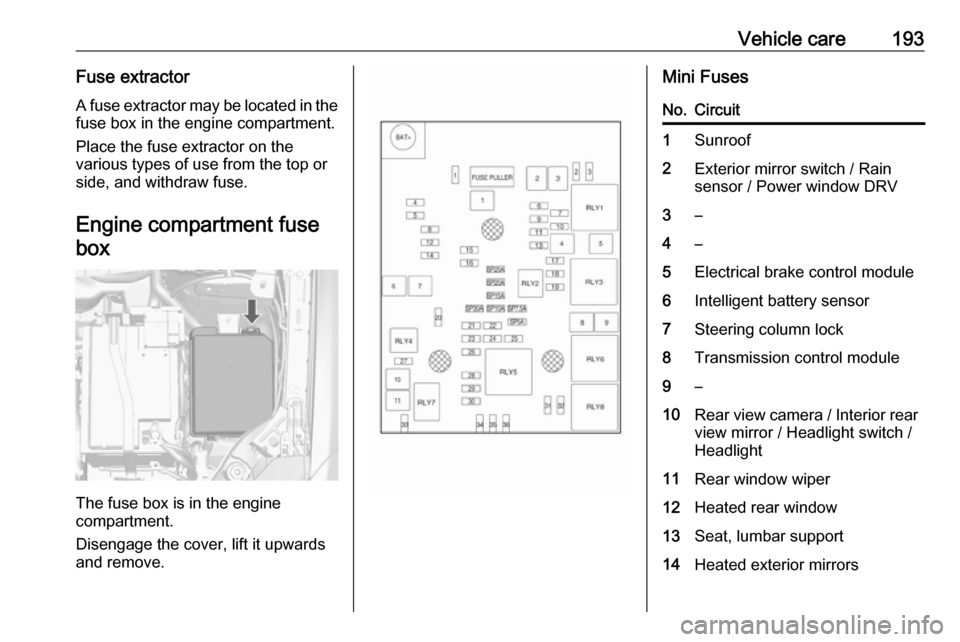headlight VAUXHALL MOKKA X 2019 Owner's Guide
[x] Cancel search | Manufacturer: VAUXHALL, Model Year: 2019, Model line: MOKKA X, Model: VAUXHALL MOKKA X 2019Pages: 253, PDF Size: 7.09 MB
Page 191 of 253

Vehicle care1895. Install the new bulb in theheadlight assembly by turning
clockwise.
6. Reconnect the wiring harness connector.
7. Install the protective cover.
For the driver side, reinstall the
windscreen washer bottle filler neck
by firmly pushing it straight into the
bottle. Ensure that the filler neck clip
engages into the underhood electrical
centre retainer.
Uplevel headlight assembly
The uplevel model vehicle has LED high beam and low beam headlights,
turn lights, a sidelight and daytime
running lights on the headlight
assembly.Front fog lights
The bulbs are accessible from the
underside of the vehicle
1. Turn the respective wheel inside to get better access and remove
three torx screws on outside of
wheel house.
Vehicle tools 3 197.
2. Pull and hold lining to get access to the bulb holder.
3.Pull the retaining rib outwards and
remove plug connector from the
bulb socket.
4. Turn the bulb holder anticlockwise
and remove it from the reflector.
5. Remove and replace the bulb socket with bulb and attach the
plug connector.
6. Insert the bulb socket into the reflector by turning clockwise and
engage.
7. Re-assemble the lining and fasten
the three torx screws.
Page 195 of 253

Vehicle care193Fuse extractorA fuse extractor may be located in the fuse box in the engine compartment.
Place the fuse extractor on the
various types of use from the top or
side, and withdraw fuse.
Engine compartment fusebox
The fuse box is in the engine
compartment.
Disengage the cover, lift it upwards
and remove.
Mini FusesNo.Circuit1Sunroof2Exterior mirror switch / Rain
sensor / Power window DRV3–4–5Electrical brake control module6Intelligent battery sensor7Steering column lock8Transmission control module9–10Rear view camera / Interior rear
view mirror / Headlight switch /
Headlight11Rear window wiper12Heated rear window13Seat, lumbar support14Heated exterior mirrors
Page 216 of 253

214Vehicle care3. Connect the black lead to thenegative terminal of the booster
battery.
4. Connect the other end of the black
lead to a vehicle grounding point,
such as the engine block or an
engine mounting bolt. Connect as far away from the discharged
battery as possible, however at
least 60 cm.
Route the leads so that they cannot
catch on rotating parts in the engine
compartment.
To start the engine: 1. Start the engine of the vehicle providing the jump.
2. After 5 min, start the other engine.
Start attempts should be made for
no longer than 15 s at an interval
of 1 min.
3. Allow both engines to idle for approx. three minutes with the
leads connected.4. Switch on electrical consumers (e.g. headlights, heated rear
window) of the vehicle receiving
the jump start.
5. Reverse above sequence exactly when removing leads.Towing
Towing the vehicle
Wrap a cloth around the tip of a flat
screwdriver to prevent paint damage.
Insert the screwdriver in the slot at the
lower part of the cap. Release the cap by carefully moving the screwdriver
downwards.
The towing eye is stowed with the
vehicle tools 3 197.
Page 219 of 253

Vehicle care217Appearance care
Exterior care LocksThe locks are lubricated at the factoryusing a high quality lock cylinder
grease. Use de-icing agent only when
absolutely necessary, as this has a
degreasing effect and impairs lock
function. After using a de-icing agent,
have the locks regreased by a
workshop.
WashingThe paintwork of your vehicle is
exposed to environmental influences.
Wash and wax your vehicle regularly.
When using automatic vehicle
washes, select a programme that
includes waxing.
Bird droppings, dead insects, resin,
pollen and the like should be cleaned
off immediately, as they contain
aggressive constituents which can
cause paint damage.If using a vehicle wash, comply with
the vehicle wash manufacturer's
instructions. The windscreen wiper and rear window wiper must be
switched off. Remove antenna and
external accessories such as roof
racks etc.
If you wash your vehicle by hand,
make sure that the insides of the
wheel housings are also thoroughly
rinsed out.
Clean edges and folds on opened
doors and the bonnet as well as the
areas they cover.Caution
Always use a cleaning agent with
a pH value of 4 to 9.
Do not use cleaning agents on hot surfaces.
Have the door hinges of all doors
greased by a workshop.
Do not clean the engine compartment with a steam-jet or high-pressure jet
cleaner.
Thoroughly rinse and leather-off the vehicle. Rinse leather frequently. Use
separate leathers for painted and
glass surfaces: remnants of wax on
the windows will impair vision.
Exterior lights
Headlight and other light covers are
made of plastic. Do not use any
abrasive or caustic agents, do not use
an ice scraper, and do not clean them
dry.
Polishing and waxing
Wax the vehicle regularly (at the
latest when water no longer beads).
Otherwise, the paintwork will dry out.
Polishing is necessary only if the paint
has become dull or if solid deposits
have become attached to it.
Paintwork polish with silicone forms a protective film, making waxing
unnecessary.
Plastic body parts must not be treated
with wax or polishing agents.
Page 249 of 253

247Control indicators.......................... 87
Control of the vehicle .................133
Controls ........................................ 76
Convex shape .............................. 32
Coolant and antifreeze ...............221
Cruise control ...................... 95, 154
Cupholders .................................. 58
Curtain airbag system .................. 50
D Danger, Warnings and Cautions ...4
Daytime running lights ...............119
Declaration of conformity ............235
DEF ............................................ 143
Delayed locking ............................ 27
Descent control system .......93, 153
Diesel exhaust fluid ....................143
Diesel fuel system bleeding .......186
Door open .................................... 96
Doors ............................................ 29
Driver assistance systems ..........154
Driver Information Centre .............96
Driving characteristics and towing tips .............................. 175
Driving hints ................................ 133
E Electric adjustment ......................32
Electrical system......................... 192
Electronic climate control system 128
Electronic driving programmes ..147Electronic key system ...................22
Electronic Stability Control.......... 152
Electronic Stability Control and Traction Control system ............93
Electronic Stability Control off....... 93
End-of-life vehicle recovery .......180
Engine compartment fuse box ...193
Engine coolant ........................... 183
Engine coolant temperature gauge ....................................... 86
Engine data ............................... 228
Engine exhaust .......................... 141
Engine identification ...................224
Engine oil ................... 182, 221, 225
Engine oil pressure ......................94
Entry lighting .............................. 124
ERA GLONASS .......................... 113
Event data recorders ..................241
Exhaust filter ............................... 141
Exit lighting ................................ 125
Exterior care .............................. 217
Exterior light ................................. 95
Exterior lighting ....................12, 115
Exterior mirrors ............................. 32
F
Fault ........................................... 147
First aid kit ................................... 72
Fixed air vents ........................... 131
Flex-Fix system ............................ 60Folding mirrors ............................. 32
Following distance indication ......159
Forward collision alert................. 157
Front airbag system .....................49
Front fog lights .............95, 122, 189
Front seats.................................... 39
Front storage ................................ 59
Fuel............................................. 168
Fuel for diesel engines ..............170
Fuel for liquid gas operation .......170
Fuel for petrol engines ...............168
Fuel gauge ................................... 84
Fuel selector ................................ 85
Fuses ......................................... 192
G
Gauges ......................................... 83
Gear shifting ................................. 93
General information ...................175
Glovebox ..................................... 58
Glove box lighting .......................124
H Halogen headlights ....................188
Hand brake ................................. 150
Hazard warning flashers ............121
Headlight flash ........................... 117
Headlight range adjustment ......118
Headlights when driving abroad 118
Head restraint adjustment .............8
Head restraints ............................ 38